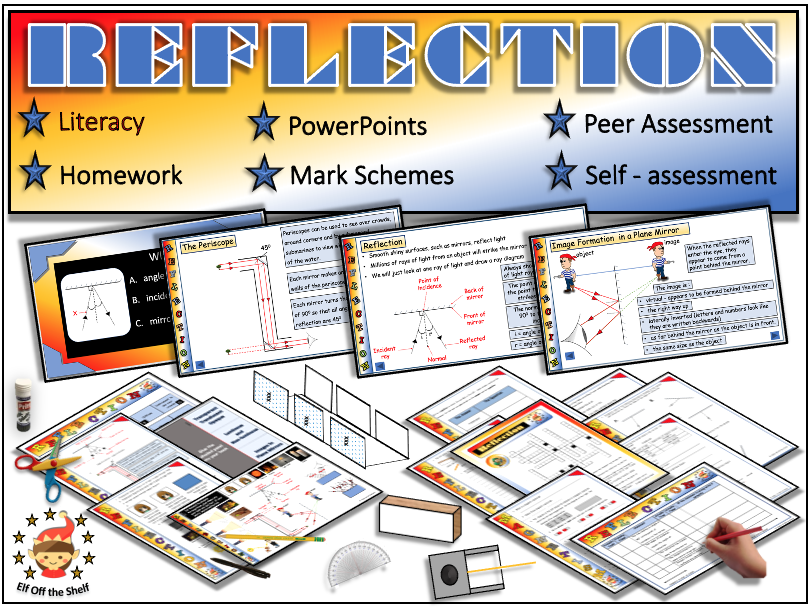Three comprehensive and fully resourced lessons on refraction, reflection and lenses for middle school.
Each topic comes with an engaging, animated PowerPoint and eleven printables which make even the more difficult concepts easy to understand.
Emphasis is placed on assessment for learning and detailed answers to questions are provided throughout, which makes self-assessment and peer assessment easy. Each topic comes with a checklist for pupils to assess their progress on completion of the topic.
Each topic comes with a one-page flow-chart lesson plan showing where logical choices between resources can be made enabling the teacher to totally bespoke lessons according to pupil ability, time available for the topic and focus of departmental/school policy Resources not used in the lesson can be additional homework or used for pre-examination revision. Many activities place an emphasis on literacy and oracy. These are identified on the flow-charts.
What’s Covered
Reflection
- Transparent, translucent and opaque materials
- Luminous and non-luminous objects
- Labelling the incident and reflected rays, the angles of incidence and reflection, the normal and the point of incidence
- Virtual experiment to prove i = r
- Ray diagram showing how the eye sees an image in a plane mirror
- The image formed in a plane mirror is upright, virtual (appears to be formed behind the mirror) laterally inverted, the same size as the object and as far behind the mirror as the object is in front.
- Ray diagram showing how the eye sees an image in a periscope
- Specular and diffuse images
Refraction
- The more dense the medium the slower the speed of light.
- When light travels from a less dense medium to a more dense medium it is bent towards the normal.
- When light travels from a more dense medium to a less dense medium it is bent away from the normal.
- Light hitting a boundary at 900 is not refracted.
- Light is not refracted at a curved boundary.
- Complete ray diagrams showing refraction.
- Design an experiment and results table to investigate refraction through a semi - circular glass block
- Why lightning is seen before thunder is heard when a cloud discharges.
- Real and apparent depth
Lenses
- Ray diagrams showing refraction in a concave and convex lens.
- Convex lenses are used in magnifying glasses, telescopes and spectacles to correct long sight.
- Concave lenses are used in lasers, flashlights, peepholes and spectacles to correct short sight.
- Label the following structures on a diagram of the eye; retina; ciliary muscle; iris; pupil; lens; suspensory ligament; optic nerve.
- Draw ray diagrams and explain how the eye sees distant and close objects.
- Draw ray diagrams and explain how lenses are used to correct long and short sight.
- Draw diagrams and explain how the iris controls the size of the pupil and therefore the amount of light which enters the eye.
- Draw a ray diagram of the pinhole camera, know that the image is inverted sand diminished, moving the object closer enlarges the image and multiple pinholes produce multiple images
- Label a diagram of the camera and explain how a picture is taken.
- Explain the differences and similarities between the eye and the camera
What’s Included for Each Lesson
- Animated PowerPoint for teaching with exit ticket quiz
- Flip it (pupil writes questions to given answers)
- Anticipation Guides (combined starter and plenary)
- Foldable
- Cut and stick activity.
- Worksheet to support the PowerPoint
- Fact sheet
- Homework plus answers
- Fact share worksheet
- Pupil progress self-assessment checklist
- Exit Ticket
- Suggested lesson plan showing choices possible between resources
For more high quality resources visit:
Something went wrong, please try again later.
This resource hasn't been reviewed yet
To ensure quality for our reviews, only customers who have purchased this resource can review it
Report this resourceto let us know if it violates our terms and conditions.
Our customer service team will review your report and will be in touch.



